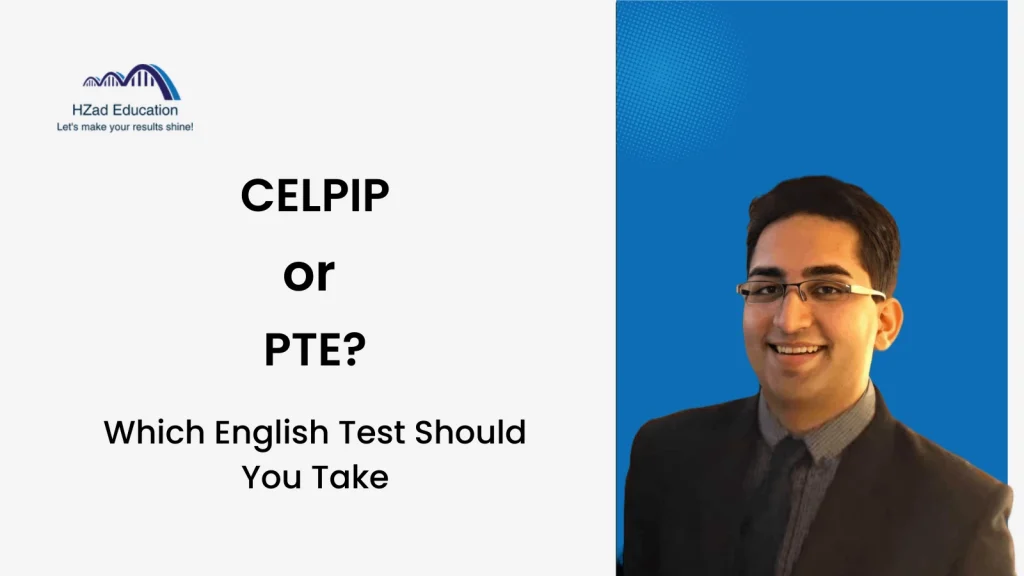Choosing an English proficiency test is an important step for applicants aiming for Canadian Permanent Residency, Citizenship, or international academic and work pathways. Among the available options, the CELPIP (Canadian English Language Proficiency Index Program) and the PTE (Pearson Test of English) stand out as two of the most widely used exams. Both evaluate the listening, reading, writing, and speaking, but they differ in scoring systems, test design, and regional availability.
CELPIP was developed in Canada and emphasizes Canadian English in real-world contexts, making it highly relevant for immigration. It is widely accepted by IRCC for PR and Citizenship applications. PTE Core, in contrast, was designed for a global audience and is accepted in multiple countries for study, work, and migration. With the introduction of PTE Core, it is now also approved by IRCC for Canadian immigration.
While both exams are computer-based, CELPIP combines AI and human scoring with limited test centers abroad, whereas PTE Core uses full AI evaluation and operates thousands of global centers. If your goal is Canada PR or Citizenship, CELPIP may be more aligned, but if you also need international recognition, PTE Core could be the better choice.
How Do the Test Structures of CELPIP and PTE Core Compare?
CELPIP mirrors real-life Canadian communication, while PTE Core reflects a structured academic exam. Both assess four skills, but CELPIP uses scenario-based speaking, Canadian-accented listening, functional reading, and real-life writing. PTE Core instead features AI-graded speaking, academic listening, reordering in reading, and essay writing. The contrast makes CELPIP more practical for daily use in Canada, while PTE Core feels global and academically oriented.
Test Format and Environment
Both CELPIP and PTE Core are fully computer-based exams, but their testing environments differ. CELPIP is delivered in a personal booth with a headset and microphone, creating real-life simulations of Canadian communication. PTE Core, by contrast, is conducted in high-tech testing centers where multiple skills are integrated into fast-paced tasks.
| Section | CELPIP Format | PTE Core Format |
| Speaking | Opinion-based and scenario-based prompts, headset recording | Automated AI tasks like “Repeat Sentence” |
| Listening | Canadian-accented real-life dialogues | Academic conversations and note-taking |
| Reading | Functional texts such as emails and announcements | Reordering paragraphs, fill-in-the-blank items |
| Writing | Practical tasks: emails, survey responses | Academic summaries and structured essays |
Exam Duration and Timing
CELPIP lasts about 3 hours, while PTE Core takes roughly 2 hours, making CELPIP longer but less intense and PTE Core shorter yet more demanding. CELPIP separates each skill into its own timed block, giving candidates pacing between tasks. PTE Core combines skills, particularly speaking and writing, into continuous segments that require quicker focus and faster recovery.
CELPIP Timing: Around 3 hours
- Listening: 46–55 minutes
- Reading: 43–56 minutes
- Writing: 53 minutes
- Speaking: 15 minutes
PTE Core Timing: Around 2 hours
- Speaking & Writing (combined): 54–67 minutes
- Reading: 29–30 minutes
- Listening: 30–43 minutes
Scoring Method and AI Evaluation
Scoring approaches differ greatly between the two exams, influencing both fairness and result timing. CELPIP uses a hybrid approach, where AI scores structural accuracy and human raters provide nuanced judgment. This balance often provides clearer feedback for improvement, supported by tools such as CELPIP AI Tests that simulate automated scoring before the real exam. PTE Core, by contrast, relies on 100% AI-based scoring, delivering results within two days with strong algorithmic consistency but limited transparency.
| Feature | CELPIP | PTE Core |
| Scoring Method | Hybrid: AI + human raters | Fully automated AI |
| Feedback Transparency | Performance descriptors, detailed reports | Limited, algorithm-driven |
| Result Time | 3–5 business days | Within 2 business days |
| Strengths | Balanced scoring, clarity in feedback | Speed, consistency across candidates |
| Limitations | Slightly longer processing time | Risk of misinterpretation, less clarity |
What Are the Costs and Rescheduling Policies for CELPIP and PTE Core?
The main differences between CELPIP and PTE Core lie in fees, refund rules, and test availability. While CELPIP is priced competitively and focuses on Canadian test centers, PTE Core costs slightly more but is accessible in thousands of locations worldwide. Rescheduling and refund policies also vary, making it important to weigh both cost and flexibility when planning.
Test Fees and Registration Cost
CELPIP and PTE Core are priced similarly, though PTE Core is usually slightly higher. CELPIP General costs CAD 290 plus taxes, while the shorter CELPIP General LS costs CAD 195 plus taxes. PTE Core, whether Academic or Core, is priced at CAD 350. All fees include registration, exam delivery, and official score reporting, though additional charges may apply for late booking, rescheduling, or score re-evaluation.
Refund and Rescheduling Policies
Refund and rescheduling options for CELPIP and PTE Core differ in timing, fees, and flexibility. Understanding these policies is important to avoid penalties and plan test bookings effectively.
CELPIP:
- 50% refund if canceled 7 days or more before the test date
- No refund if canceled within 7 days of the test
- First reschedule is free when requested 7 days in advance
- Additional reschedules cost CAD 50 plus tax
- Changes must be made through the official Paragon online portal
- Missed tests are non-refundable
PTE Core:
- 100% refund if canceled 14 days or more before the test date
- 50% refund if canceled 8–13 days before the test
- No refund if canceled within 7 days
- Free rescheduling if requested 14+ days in advance
- Within 14 days, candidates must cancel and rebook with new fees
- All changes are handled through the myPTE Core online portal
Both tests emphasize strict timelines, non-refundable late changes, and portal-only modification methods, so planning in advance is essential.
Availability of Test Centers
Test center access is an important factor when choosing between CELPIP and PTE Core. CELPIP is primarily offered in Canada with a limited presence internationally. PTE Core, by contrast, operates on a larger global scale, with availability in more than 100 countries. For international candidates, these differences affect travel requirements, scheduling flexibility, and overall convenience, making availability a key deciding factor.
- CELPIP: 180+ locations worldwide, including Canada, Australia, and select international sites
- PTE Core: 3,000+ centers available in 100+ countries globally
Selecting the exam based on the nearest accessible center can help minimize travel time and extra expenses
Are CELPIP and PTE Core Accepted for Canada PR and Other Visas?
CELPIP is primarily accepted for Canadian immigration, while PTE Core offers broader global recognition. For Canada PR, both CELPIP General and PTE Core are approved by IRCC, and CELPIP LS is accepted for Citizenship. PTE Academic is not valid for PR but is widely recognized by universities and governments for study and work visas, making it a more versatile choice outside Canada.
IRCC Approval and Test Recognition
Both CELPIP-General and PTE Core are approved by IRCC for Permanent Residency, while CELPIP-General LS and PTE Core are also valid for Canadian Citizenship. IRCC uses the Canadian Language Benchmarks (CLB) scale to standardize results across tests, making it easier to compare CELPIP and PTE Core scores for eligibility.
| CELPIP Score | PTE Core Score | CLB Level |
| 12 | 86–90 | CLB 12 |
| 11 | 83–86 | CLB 11 |
| 10 | 79–83 | CLB 10 |
| 9 | 73–79 | CLB 9 |
| 8 | 65–73 | CLB 8 |
| 7 | 58–65 | CLB 7 |
| 6 | 50–58 | CLB 6 |
| 5 | 43–50 | CLB 5 |
| 1- 4 | 36–43 | CLB 1-4 |
| 0 | – | – |
This equivalency helps candidates compare results directly across both tests and understand how their scores map to IRCC requirements for immigration and citizenship pathways.
Institutional and Regional Acceptance
PTE Academic has broad global recognition for study, work, and migration visas, while CELPIP is mainly limited to Canadian immigration and citizenship. PTE Academic is officially accepted by governments in Australia, the UK, New Zealand, and Ireland, and it is recognized by leading universities such as Oxford University, Harvard Business School, Yale, and the University of Melbourne. This makes it a strong choice for international students and professionals.
CELPIP, on the other hand, is designed almost entirely for Canadian immigration under IRCC, with little use outside of PR and Citizenship pathways. Its narrow scope makes it highly specialized but less versatile compared to PTE Core.
Which English Test Is Easier: CELPIP or PTE Core?
CELPIP is often seen as more approachable because it uses everyday Canadian scenarios and provides slightly more time per task. This structure can reduce stress for candidates who are familiar with Canadian English and prefer practical communication over rapid-fire academic prompts.
PTE Core, in contrast, moves at a faster pace and is fully AI-scored, which some find more demanding. Yet its quick two-day results are a strong advantage. The reality is that both tests feel easier with the right preparation. Focused practice not only builds familiarity with each format but also reduces exam-day anxiety. That’s why structured support, such as our 15-hour all-inclusive PTE course and specialized CELPIP classes, can make a significant difference in improving performance and confidence.
Ease of Speaking Section
CELPIP offers role-play tasks with more planning time, while PTE Core requires rapid responses to automated prompts. In CELPIP, candidates speak into a headset and respond to everyday Canadian scenarios, which many find closer to natural conversation. The extra thinking time helps test takers organize their responses with less pressure.
PTE Core speaking tasks, such as “Repeat Sentence” or “Describe Image,” move quickly and allow almost no preparation. Responses are scored entirely by AI, which increases consistency but can feel less personal. For many, the choice depends on comfort, whether they prefer the structured, real-world style of CELPIP or the fast-paced, automated style of PTE Core.
Scoring Transparency and Feedback
CELPIP provides clearer scoring through human raters and descriptors, while PTE Core relies entirely on AI with less visible criteria. CELPIP uses a hybrid model where human examiners evaluate speaking and writing against defined benchmarks, giving candidates a better sense of what influenced their score. This transparency helps many test takers trust the results and use feedback to improve.
PTE Core, in contrast, is fully AI-scored with no human involvement. While this ensures speed and consistency, candidates often find the evaluation less interpretable since the algorithm does not provide detailed descriptors. As a result, test takers who value nuanced human judgment may feel more confident with CELPIP, whereas those prioritizing faster, automated results may prefer PTE Core.
Familiarity with Test Format
CELPIP feels more familiar for daily communication, while PTE Core reflects an academic testing style that may seem more technical. CELPIP tasks mirror Canadian life, making the test intuitive for those exposed to local contexts. PTE Core, by contrast, emphasizes academic problem-solving, which can feel less natural without prior exposure.
CELPIP:
- Canadian context with email writing, voice responses, and surveys
- Mimics real-life communication and daily language use
PTE Core:
- Academic context with paraphrasing, summarizing, and multiple-choice questions
- Interface and task style may feel more technical to some candidates
Familiarity often influences confidence, so preparation and practice with the chosen format can greatly improve performance.
Frequently Asked Questions
How long do PTE Core and CELPIP results take?
PTE Core results are usually released within 2 business days, while CELPIP results take about 4–5 business days. The faster turnaround of PTE Core appeals to candidates on tight deadlines, while CELPIP’s slightly longer process reflects its hybrid scoring, which includes human evaluation for more detailed feedback.
Is CELPIP accepted outside Canada?
CELPIP is primarily recognized in Canada for PR and Citizenship applications, with limited acceptance abroad. Some institutions in countries like the United Arab Emirates and India do offer CELPIP testing, but its use remains almost entirely focused on Canadian immigration programs.
Can I reschedule or cancel my English test?
Yes, both CELPIP and PTE Core allow rescheduling or cancellation, but the rules differ. CELPIP permits changes up to 7 days in advance, with the first transfer free and later changes costing a fee. PTE Core requires at least 14 days for a full refund, 8–13 days for a 50% refund, and no refund if less than 7 days remain. Both systems operate through online portals only.
Is PTE Core accepted for Canada PR?
Yes, but only the PTE Core is approved by IRCC for Canadian Permanent Residency. PTE Academic is not valid for PR, though it remains widely recognized for student visas, academic admissions, and work permits in countries such as Australia, the UK, and New Zealand.


